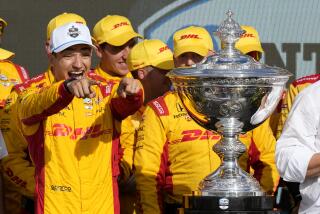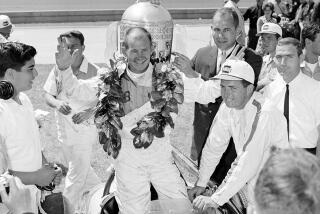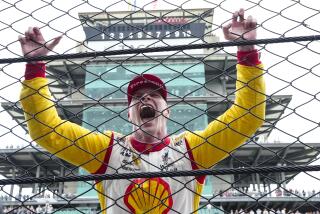THE INDIANAPOLIS 500 : Why Aren’t Women Racing at Indy? Ask Guthrie
It was 10 years ago, in 1977, that Janet Guthrie became the first woman to drive in the Indianapolis 500. She’s proud that she has the distinction of being the first. But she’s piqued that she still has the distinction of being the only.
Why is Guthrie no longer driving Indy cars? And why have no other women followed her lead to Indy?
“The stick-and-ball sports editors who suggested that you ask me that question are probably the same guys who are still puzzling over the question of why there are no black managers in baseball,” Guthrie said.
Guthrie keeps answering the question, though. She’s been doing it for years. And every time she does, she suffers the consequences.
She explains about the high cost of racing, the dependency on multi-million dollar corporate sponsorship, the good ol’ boy network that keeps racing very male--and then the good ol’ boys explain that women can’t race.
It’s kind of like saying that women don’t have the “necessities” for racing.
“Get ready for the knee-jerk reaction,” Guthrie said. “I’ll talk to you about this, and I’ll guarantee what the reaction will be because I’ve been through this 14 dozen times. It will be written off by men who will say that women can’t compete and, more specificly, that Janet Guthrie wasn’t competitive.
“I know that that is not true. I stand on my record. . . . But it’s hard to have your reputation kicked around again and again.”
Guthrie, 49, lives in Aspen, Colo., and is busy working on an autobiography that she hopes will show the “passion and complexity” of the world of auto racing. She is engaged to Warren Levine, a United Airlines pilot. And she still does a lot of traveling and speaking.
Guthrie would be in Indianapolis racing today if she could get the sponsorship. “Obviously there is money available to sponsor racing because the race fields remain full of sponsored men,” Guthrie said. “Sponsors supposedly put up that money because they want to sell products, but a lot of those products are used by both men and women--beer, for example. But what I especially notice are the sponsors like Tide, Crisco, Folgers and Haines pantyhose who are putting their money behind men.
“Men are getting sponsorship and women can’t. That sounds unfair. But who cares about unfair? What counts is the bottom line. Sponsors want the publicity that racing brings. But a successful woman driver will get 10 times the attention that a man will get. So, now, what really is important?
“It keeps coming back to the good ol’ boy network. A lot of corporations are spending a lot of tax deductable dollars to sponsor male racing drivers.”
And the only way to justify passing over a driver like Guthrie is to say that she can’t drive.
“I would like to point out that when I was racing, there were some very good teams that would have had me that I would have given my eye teeth to work with--Bignotti for example, McLaren for example--but I had to bring the sponsorship with me, and I was being told that there was no sponsorship available,” Guthrie said.
The way it’s retold in Gasoline Alley, she didn’t really merit sponsorship.
A quick review:
Janet Guthrie did not show up at Indy in 1976 as a publicity stunt. She was a 38-year-old woman who had a degree in physics and had worked as an engineer for Republic Aviation.
She learned to fly planes when she was 13. She had been racing sports cars for more than 10 years and was able to take the engine of her Jaguar XK-120 apart and put it back together.
Guthrie was quite serious about wanting to race cars.
She conducted herself in a calm, professional manner at all times, enduring constant scrutiny as she went through some frustrating setbacks with her cars and some cutting remarks from other drivers.
She failed to qualify her first year at Indy because her car was not fast enough. A.J. Foyt was curious enough about her ability to let her take his backup Coyote out to see if she could get a good car up to qualifying speed. She could. But he couldn’t afford to go handing out his backup car, so she ended up driving in the World 600 stock car race on the day of the Indy 500.
In 1976 she was in the running for rookie of the year on the NASCAR circuit.
In 1977 she was back at Indy with a car that was good enough to make the field--barely. She qualified 26th and finished 29th after spending more time in the pit than on the track.
After taking on a full load of fuel, the heat of the day and the heat of the car caused the fuel to expand and spill over into her lap. She wore that methanol fuel-soaked suit for hours before she was able to get it off and find some water to rinse away the burning chemical. There was, then, just one shower in Gasoline Alley, so she had to have her crew construct a makeshift shower stall for her.
She commented to the reporters shadowing her and recording her every word that one shower was hardly adequate.
In 1978, she qualified 15th and finished 9th.
Not bad at all for a second try. And, she points out, that she did that with a budget that was about 5% of what the top teams were spending that year. She had $120,000 while the Penske team had about $2.3 million.
So did her cohorts herald her arrival and proclaim her worthy of promotion? No, but they couldn’t say that she was scared or dangerous or didn’t know the sport or didn’t know cars. So they said that she ran just to finish. That she didn’t challenge the leaders.
To that, she says “horsefeathers.”
In 1979 she was back in a car that lasted just three laps. It was the car that didn’t want to challenge the leaders. And she hasn’t been back in the race since.
She would still like to race with a top team so that she would have the wherewithal to challenge.
There were, in her early days in Indy cars, some drivers who showed her respect. Foyt, for one, was willing to give her a chance. After a race at Trenton, Johnny Rutherford acknowledged that she had made a quick transition from sports cars and said, “It’s a shame she didn’t have a better car.” Tom Sneva said, “She ran as fast as the car would run.”
But others continued to say that she was just trying to finish, not trying to win.
She’s heard it all over the years, about how women don’t have the strength, endurance or courage for this sport.
Ever the intellectual, Guthrie counters each point with evidence: “OK, let’s talk about strength. How about the 115-pound woman powerlifter who (can) lift 352 pounds? Endurance? What about the ultra-marathon runners and triathletes? The record for the English channel swim is held by a woman. Courage? Downhill skiers risk terrible injury. A gymnast doing a triple back flip on a balance beam constantly risks breaking her neck. How about Betty Cook, a world champion in power boat racing.
“How about all of those things and more, all in one? The Iditarod (a dogsled race of more than 1,000 miles in Alaska). In each of the last three years, that’s been won by a woman. I have a T-shirt that says, ‘Alaska. Where men are men and women win the Iditarod.’
“Women just can’t do it? Horsefeathers. I find that highly offensive.”
Guthrie is convinced that it’s the system that is keeping women from developing into top drivers. She cites examples dating back to the early 1900s in which women of independent wealth successfully ran sports cars.
And she cites the WASPs of examples of how men will strive to deny the history of women who succeed on their turf. The Women Air Force Service Pilots flew planes to and from the war theaters. Thirty-nine were killed in the line of duty during World War II. But they didn’t win veterans benefits until 1977, because the military was so determined to keep them classified as civilians.
“We can go all the way back to hot air balloonists in the 1700s to find examples of how women’s history has been deliberately suppressed or denied.”
So Guthrie is not at all surprised that her efforts of 10 years ago not only have not led to greater opportunities for women, but are more often shrugged off as an experiment by someone who was not competitive.
“Am I surprised that there haven’t been other women at Indy in the last few years?” Guthrie asked. “I’m distressed.
“There have been some great natural talents emerge, like Kathy Rude (who survived a terrible racing accident four years ago) and there will be others. Whether they get the chance to drive at Indy is a matter of funding.
“Me? I keep hoping that one of these days, somewhere in Aspen, I’ll run into a multi-zillionaire who wants to go racing.
“I’d love to have the money behind me for the car, the team, the testing program that it takes to be competitive.”
More to Read
Go beyond the scoreboard
Get the latest on L.A.'s teams in the daily Sports Report newsletter.
You may occasionally receive promotional content from the Los Angeles Times.










